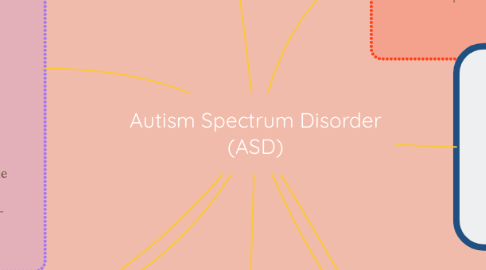Autism Spectrum Disorder (ASD)
by Ruth Kang

1. Characteristics of ASD: -Non-verbal reasoning -Exceptional memory -Perceptual motor skills (hand-eye coordination, body-eye coordination, auditory language skills) -Computer proficiency -Exceptional skills in creative and imaginative expression (music, art, writing, drama) -Visuospatial ability (capacity to identify visual and spatial relationships among objects)
2. Characteristics: - Impairment in social relationships, -failure to respond to their names when called, appearing not to listen when spoken to, an inability to display appropriate facial expressions, avoidance of eye contact, a failure to respond to affection, -young children with autism will often fail to respond or exhibit delays in responding to the gestures, - Unusual toy play, -inability to form friendships.
3. Insufficient communication and use of language, Perseverating on interests and activities, Dependence on routine, Unconventional reaction to sensory stimulation, behavioural problems (meltdowns, self-injury, property destruction and acts of aggression), Variability of intellectual functioning, Difficulties with sleeping, toileting and eating, Immune irregularities
4. Screening tools are designed to help identify children who might have developmental delays: a positive screening result should be followed up with your child’s health care provider immediately
5. Types of Screening Tools: -Ages and Stages Questionnaires (ASQ) -Communication and Symbolic Behavior Scales (CSBS) -Parent’s Evaluation of Development Status (PEDS) -Modified Checklist for Autism in Toddlers (M-CHAT) -Screening Tool for Autism in Toddlers and Young Children (STAT) -Observation tools such as the Autism Diagnostic Observation Schedule (ADOS-G) -The Childhood Autism Rating Scale (CARS) -The Autism Diagnostic Interview – Revised (ADI-R)
6. Autism Spectrum Disorder is a neurodevelopmental disorder that impacts brain development.
6.1. Experience communication problems, difficulty with social interactions and a tendency to repeat specific patterns of behaviour - Restricted range of activities and interests
7. Co-occurring medical conditions such as epilepsy, sleep disorders, gastrointestinal (gut) abnormalities and immune dysregulation. Mental health issues such as anxiety and depression are common
8. The condition covers a wide spectrum, with individual differences in the following: -Number and particular kinds of symptoms -Severity: Mild to severe -Age of onset -Levels of functioning -Challenges with social interactions.1 in 54 children and youth between 5 and 17 years of age have been diagnosed with ASD (the National ASD Surveillance System 2018 report).
9. Autism is a lifelong condition. Thus adults with ASD deserve appropriate medical care, social support, educational accommodations, employment opportunities and housing


